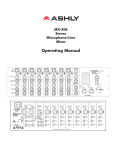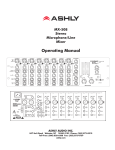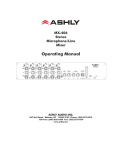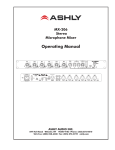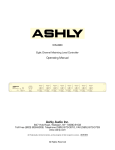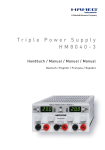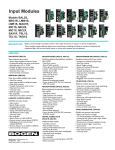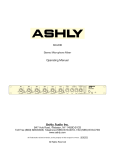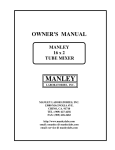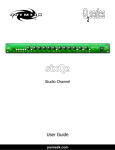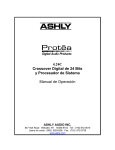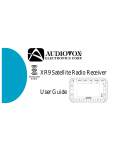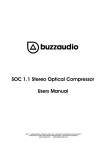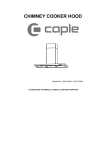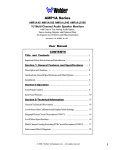Download Ashly ITC-2 Specifications
Transcript
MX-508 Stereo Microphone/Line Mixer Operating Manual ASHLY AUDIO INC. 847 Holt Road Webster, NY 14580-9103 Phone: (716) 872-0010 Toll-Free: (800) 828-6308 Fax: (716) 872-0739 Internet: http://www.ashly.com/ Operating Manual -MX-508 Stereo Microphone/Line Mixer Table Of Contents 1 INTRODUCTION . . . . . . . . . . . . . . . . . . . . . . . . . . . . . . . . . . . . . . . . . . . . . . . . . . . . . . . 3 2 UNPACKING . . . . . . . . . . . . . . . . . . . . . . . . . . . . . . . . . . . . . . . . . . . . . . . . . . . . . . . . . . . . 3 3 AC POWER REQUIREMENTS . . . . . . . . . . . . . . . . . . . . . . . . . . . . . . . . . . . . . . . . . . . 3 4 CONTROLS . . . . . . . . . . . . . . . . . . . . . . . . . . . . . . . . . . . . . . . . . . . . . . . . . . . . . . . . . . . . 4-5 5 CONNECTIONS AND CABLES . . . . . . . . . . . . . . . . . . . . . . . . . . . . . . . . . . . . . . . . .6-7 6 TYPICAL APPLICATIONS . . . . . . . . . . . . . . . . . . . . . . . . . . . . . . . . . . . . . . . . . . . . . . 6.1 Small Sound Reinforcement System . . . . . . . . . . . . . . . . . . . . . . . . . . . . . . . . . . . . 6.2 Meeting Room, Board Room, Church, etc. Using Remote Control . . . . . . . . . . 6.3 Location Recording or Broadcast Mixing . . . . . . . . . . . . . . . . . . . . . . . . . . . . . . . . 6.4 Submixer In Larger Sound System . . . . . . . . . . . . . . . . . . . . . . . . . . . . . . . . . . . . . . 7 CHANGING FACTORY CONFIGURATIONS . . . . . . . . . . . . . . . . . . . . . . . . . . . . . 9 7.1 Changing the Aux Pre/Post Assignment . . . . . . . . . . . . . . . . . . . . . . . . . . . . . . . . . 9 7.2 Installation of Input Transformers . . . . . . . . . . . . . . . . . . . . . . . . . . . . . . . . . . . . . 10 8 TROUBLESHOOTING TIPS . . . . . . . . . . . . . . . . . . . . . . . . . . . . . . . . . . . . . . . . . . . . 8.1 No Sound . . . . . . . . . . . . . . . . . . . . . . . . . . . . . . . . . . . . . . . . . . . . . . . . . . . . . . . . . . . 8.2 Distorted Sound . . . . . . . . . . . . . . . . . . . . . . . . . . . . . . . . . . . . . . . . . . . . . . . . . . . . . 8.3 Excessive Noise . . . . . . . . . . . . . . . . . . . . . . . . . . . . . . . . . . . . . . . . . . . . . . . . . . . . . 8.4 Excessive Hum . . . . . . . . . . . . . . . . . . . . . . . . . . . . . . . . . . . . . . . . . . . . . . . . . . . . . . 9 DIMENSIONS . . . . . . . . . . . . . . . . . . . . . . . . . . . . . . . . . . . . . . . . . . . . . . . . . . . . . . . . . . 10 8 8 8 9 9 10 10 10 10 10 10 SPECIFICATIONS . . . . . . . . . . . . . . . . . . . . . . . . . . . . . . . . . . . . . . . . . . . . . . . . . . . . . 11 11 WARRANTY INFORMATION . . . . . . . . . . . . . . . . . . . . . . . . . . . . . . . . . . . . . . . . . . 11 12 SCHEMATIC DIAGRAMS . . . . . . . . . . . . . . . . . . . . . . . . . . . . . . . . . . . . . . . . . . . 12-15 2 Operating Manual - MX-508 Stereo Microphone/Line Mixer 1. INTRODUCTION 2. UNPACKING Congratulations on your purchase of an Ashly MX-508 stereo mixer. In one compact rack-mount package we have combined features, reliability, and sonic performance previously found only in larger and more expensive mixing consoles. This second generation mixer is similar to the MM-508, with the addition of output mute switches on stereo outputs and double or single jack insert points on all input channels. As a part of our system of quality control, every Ashly product is carefully inspected before leaving the factory to ensure flawless appearance. After unpacking, please inspect for any physical damage. Save the shipping carton and all packing materials , as they were carefully designed to reduce to minimum the possibility of transportation damage should the unit again require packing and shipping. In the event that damage has occurred, immediately notify your dealer so that a written claim to cover the damages can be initiated. Other features include optional plug-in isolation transformers on all inputs, switchable +48V phantom power, and front panel switching on each channel selecting between mic or line input. Three-band equalization with a fixed frequency low and high shelf and a tunable mid-range control provides perfect true-reciprocal equalization curves. A concentric level and pan control combined with a concentric pair of auxiliary sends complete each input channel. Ultra low-noise summing amplifiers combine the channel signals for the main and send outputs. Two 10segment LED arrays monitor main or aux outputs. Standard line level outputs on 1/4" connectors, tape outputs on RCA connectors, and transformer isolated 600 ohm outputs on XLR connectors are provided as standard equipment. Ashly still uses professional quality 16mm metal shaft potentiometers on all controls for greater accuracy and long life. The right to any claim against a public carrier can be forfeited if the carrier is not notified promptly and if the shipping carton and packing materials are not available for inspection by the carrier. Save all packing materials until the claim has been settled. 3. AC POWER REQUIREMENTS The MX-508 mixer will perform normally from 93 to 125 volts AC, 50-60Hz (some export models are wired for 240 Volts and are labeled accordingly). Use only properly grounded AC receptacles. To reduce the risk of ground loop hum, use a central point for system AC power distribution. In the event of fuse failure, replace only with same type fuse. Power consumption is less than 50 watts. 3 Operating Manual -MX-508 Stereo Microphone/Line Mixer 4. CONTROLS -40 0 - -30 Input Level -50 +22 -20 -60 -24 dB Ch.1 M L Clip 4.2 Mic-Line Switch This switch selects between the XLR microphone input or the 1/4" line input jack as the signal source. It can also serve as a "channel mute" switch when selected to the unused input. High EQ -12 630 Mid EQ Frequency -12 +12 1.2K 2.5K 5K +12 Low EQ -12 4.1 Input Level (Gain) This control sets the operating level of the Microphone preamp and Line Input. Best signal to noise ratio is obtained with higher gain settings. It is therefore desirable to set the Gain control as high as possible while still leaving enough headroom (usually 20dB) to prevent distortion. +12 Aux1 Aux2 0 Aux 1 10 Aux 2 0 Level 10 Pan Level Pan 3 1 4.3 Channel Clip Indicator This peak sensitive indicator monitors all level critical points in the input channel and illuminates if any of them reach levels 3 dB below clipping. 4.4 Equalization Channel EQ consists of a high shelf control at 15KHz (middle of shelf), a sweepable mid control, and a 70Hz low shelf control. The mid control is sweepable from 140Hz to 8KHz with a bandwidth of approximately 1 octave. 4.5 Aux Sends These are an additional pair of level controls to adjust the feed to monitors or effects units. Aux 1 is factory preset to pre-fader, pre-EQ, while Aux 2 is post-fader, post-EQ. Both Aux sends can be internally switched to pre or post fader/EQ. Note: See section on changing factory configurations. 4.6 Level and Pan This concentric pair of controls adjusts the level and stereo position of the channel. Aux Master 10 Mic 0 Line Aux 1 Send p 0 10 Aux 2 Send 4.7 Aux Master Sends These controls adjust the overall gain of the output stages for the Aux 1 and Aux 2 outputs. 4.8 Aux Master Returns With Pan These concentric level and pan controls adjust the returning signal from effects units or auxiliary inputs to the Main Left and Right outputs. Return 1 is stereo and return 2 is mono. If only the right connection to return 1 is made, this return will function as mono with pan. 4.9 Tape/CD Input and Send This stereo level control adjusts the Tape/CD input to the Main Stereo outputs. The outer concentric control labeled "To Aux 1" sums the left and right Tape/CD inputs to a mono signal and applies it to the Aux 1 Master group for use with monitors or effects. It is "pre-fader", or independent of the stereo level control. 0 0 Return 2 0 Tape/CD In 4 10 Return 1 Pan (Stereo) 10 Pan 10 To Aux 1 Operating Manual - MX-508 Stereo Microphone/Line Mixer 4.10 Output Meters A pair of peak reading 10 segment LED meters are used to indicate output level. Green LED's are used below 0 VU, yellow above 0 VU and red LED's indicate clipping. 0 VU is equivalent to +4 dBu (1.228Vrms). This meter pair is switchable (with the headphone output) to either the Main Left and Right outputs or the Aux 1 and 2 outputs. The red clip LED's will illuminate if the summing amplifiers are clipping even if the main output controls are off, in which case one or more inputs must be turned down. Note: The output meters are accurately calibrated to the transformerless output levels, but not necessarily the transformer-balanced outputs. See note on Transformer Balanced Outputs. Clip +6 +3 0 -3 -6 -9 -12 -15 -18 -21 -L- (Aux1) VU 4 6 7 8 1 0 6 7 2 8 0 9 10 0 10 Headphones Meter/ Phones Select Right 2 3 -R- (Aux2) Left 3 5 Mono Output Mute 5 4 1 Mute 4 Phantom (+48V) MX508 Stereo Eight Channel Mixer 9 10 4.13 Phantom Power Switch This front panel switch enables the 48 Volt phantom power supply for condenser microphones which can use this feature. One switch controls all the inputs. If you have a mix of condenser and dynamic microphones, the phantom power will not affect the operation of the dynamic mics. 6 L/R Aux 1/Aux 2 7 3 8 2 1 0 4.11 Main Output Level Main These controls deOutputs termine the level of both transformer balanced and transformerless output stages for the Main Left and Right outputs. 4.12 Main Output Mutes These switches turn off both the transformer-balanced outputs as well as the transformerless 1/4" stereo outputs, and indicate the mute mode by lighting the red LED near the switch. The headphone and metering functions continue uninterrupted even though there is no signal on the mixer's main outputs. 5 9 10 Off Power On 4.14 Mono Output Level This control adjusts the level of the summed mono output. It is completely independent of the Main Left and Right masters. 4.15 Headphones Level This control adjusts the level of the designated output signal (Mains or Aux) to the headphone jack. 4.16 Meter/Phones Select This switch selects either the Main Left/Right outputs or the Aux 1/Aux 2 outputs to the LED meters and the headphone jack. 4.17 Headphone Output This front panel 1/4" TRS connector feeds a standard set of stereo headphones. A selector switch that also controls the level meter allows monitoring the main or Aux outputs. 5 Operating Manual -MX-508 Stereo Microphone/Line Mixer 5. CONNECTIONS AND CABLES The MX-508 mixer is fitted with four types of audio connectors: 3-pin XLR type male (stereo outputs), 3-pin XLR type female (mic inputs), tip-ring-sleeve (TRS) phone jack, and RCA jack. Certain 1/4" jack connections use an unbalanced mono plug, which is also shown. Tip (+) Stereo Phone Plug used for balanced Tip (+) Sleeve (Ground) Mono Phone Plug used for unbalanced XLR pins are numbered in the connector insert. XLR Male 2 = (+) 3 = (-) 1 = (gnd) XLR Female RCA Plug Tip = (+) Sleeve = ground Two-conductor (twisted pair) shielded cable is best for all XLR type connections. Belden No. 8412, or its equivalent, is an excellent cable due to its heavy construction. This type of cable should be used for all portable applications. Snake cables containing multiple shielded pairs must be handled very carefully because the leads tend to be fragile, and a broken conductor is difficult to repair. If low level and high level lines (e.g., microphones and mixer line outputs), or if either of these lines and speaker cables are run parallel for long distances, crosstalk may be significant. In fact, the crosstalk (signal leakage between cables) can cause an electronic feedback loop, oscillation, and possibly damage to the equipment. To minimize crosstalk, physically separate low level (microphone) cables from speaker cables by the greatest feasible distance. At any point where cables meet, run low level cables perpendicular to high level or speaker cables. If low and high level or speaker cables must be run parallel and in close proximity to one another, they should be bundled separately. 6 5.2 Input Pad The Pad is a 20dB attenuation switch on the rear panel for use with the XLR microphone input. It has no effect on the line input. It should normally be left in the "out" position for best signal to noise ratio and should only be used when the input is being overdriven with the Gain control at its minimum setting. 5.3 Line Input The line input is a standard 1/4" TRS active balanced connection, with a balanced input impedance of 20KΩ. It will accommodate a wide range of input levels. Ch.1 Pad (-20dB) Mic Input PUSH PUSH Ring (-) Sleeve (Ground) 5.1 Microphone Input The microphone input is an active balanced type with a nominal impedance of 1200 ohms. Its noise performance is best with a 200 ohm microphone. A plug-in transformer option is available if you need the isolation. The Mic input connector is a standard 3-pin XLR female with the shield on pin 1, the (+) in-phase connection on pin 2, and the (-) outof-phase connection on pin 3. Line Input Send* TRS (Insertion ) Return 5.4 Channel Send And Return Patch A channel patch point allows a device such as graphic equalizer, noise gate, compressor/limiter, remote level controller, or direct out recording device to be used on individual channels. The MX-508 has both single jack insert capabilities as well as separate send and return jacks. - To use separate send and return jacks, use the send jack to feed the input of the device to be inserted, and use the return jack for the output of the inserted device. You must use unbalanced (tip-sleeve) mono plugs for this configuration. - To use the single jack insert, use a TRS (stereo) plug in the send jack only, where the send output signal is on the tip, and the return signal is applied to the ring. This convention is most common among mixers. - To use the send jack as a Direct Line Output (pre EQ), you must use a special cable with tip and ring connected at the MX-508 Send and a tip-sleeve mono plug at the other end. Connecting tip and ring at the mixer send jack is necessary for uninterrupted signal within the mixer when using direct line outputs. Operating Manual - MX-508 Stereo Microphone/Line Mixer 5.5 Aux Send Outputs The Aux Outputs are used to drive monitors, effects processors, recording devices, or any function which requires isolated level control from the main outputs. They are pseudo-balanced 1/4" tip-ring-sleeve. Transformer Balanced -R- Output -LAux 1 Send 5.6 Aux Return Inputs The return inputs are 1/4" unbalanced. Return 1 is stereo with a left and right input, while Return 2 is mono. To use return 1 as mono, connect only to the Right return 1 input. 5.7 Tape/CD Input - Tape Output The stereo inputs on RCA connectors have a nominal operating level of -10dBu to match most tape decks and CD players. The tape outputs are -10dBu "pre-master", so they are not affected by the settings of the Main output controls. 5.8 Transformer Balanced Outputs The transformer outputs use male XLR type connectors and provide total isolation for 600 ohm lines. Pin 1 is ground, pin 2 is (+), and pin 3 is (-). These outputs are controlled by the Left and Right Master levels, with a nominal operating level of +4dBu. Ch Aux 2 Send Right Left (Mono) Transformerless Output -R- -LR/L Sub Out -R- -LAux 1 Aux 2 Sub Out Mono Output -Rof ot Note: The transformer-balanced outputs are designed to drive up to +24dBu into 600 ohm loads. Because of the nature of an output transformer, the output level increases as the impedance of the terminating load becomes higher than 600 ohms. Whereas a "directcoupled" output stage like that of the transformerless outputs will not change as the load changes, any transformer used in an audio path is affected by its termination impedance. Since line level inputs on audio devices are typically 10KΩ or higher, expect a slight increase (2.5dB) in output level when driving high impedance inputs with the transformer outputs. The output meters will remain accurately calibrated to the levels present on the transformerless outputs, regardless of the load on the transformer outputs. 5.9 Main Outputs These Main Outputs are also controlled by the left and right master. They are 1/4" pseudo-balanced TRS jacks with a nominal operating level of +4dBu into any load. Pad Return 1 Return 2 Aux 1 Aux 2 Sub In Tip=Aux 1 Ring=Aux 2 Tape/CD Input -LR/L Sub In Tape Out -L- -R- 5.10 Sub Outputs These outputs are generally used to feed another mixer's Sub Inputs for expanded input capacity. The Main left and right submaster outputs use unbalanced (mono) 1/4" connectors. The Aux submaster outputs use 1/4" TRS connectors with Aux 1 on the tip and Aux 2 on the ring. 5.11 Mono Output This output is a function of the Mono Level Control, which is a pre-Master summed output from the left and right mix busses. Like the main outputs, it is pseudobalanced with a nominal level of +4dBu. 5.12 Sub Inputs These inputs are useful for linking together two or more mixers for expanded input capacity, and include Main left, Main right, and Aux 1/Aux 2. Signal to the Sub Inputs is taken from the Sub Outputs of another mixer, with a nominal level of +4dBu. The Aux submaster input requires Aux 1 on the tip and Aux 2 on the ring. 7 Operating Manual -MX-508 Stereo Microphone/Line Mixer 6. TYPICAL APPLICATIONS: 6.1 Small Sound Reinforcement System: In the setup shown here, the MX-508 is used to mix typical sound sources that might be found in a small club, school theater or similar environment. Six of the input channels are used for microphones for live vocal or instrumental pickup. The remaining two channels are used for playback from a stereo tape recorder, such as might be used during intermission, for backup, for special recorded effects, etc. The power amplifier (or any additional equalizers or electronic crossovers which may be used) is fed from the transformer balanced Output connectors. Amplifier Speaker Zone 1 Amplifier Speaker Zone 2 8 Mic/Line Inputs Tra nsfo rmer Balanced Output -R-LAux 1 Se nd 120 VAC 50-6 0Hz Fuse 3AG 1A Tra nsfo rme rles s Output Ash ly Audio Inc. Mad e In USA -R- To reduce the risk of electric shock do not Mo no remove cover. No user serviceable parts inside. Output Refer servicing to qualified personnel. To reduce the risk of fire replace with same type fuse. To reduce the ris k of fire or ele ctric shock do not expose this equipment to rain or mois ture. Ch .7 Ch .6 Ch .5 Ch .4 Ch .3 Ch .2 Ch .1 Pad (-20d B) Pad (-20dB ) Pad (-20dB ) Pad (-20d B) Pad (-20d B) Pad (-20dB ) Pad (-20dB ) Mic Input Mic Input Mic Input Re turn 1 Line Input Return 2 -R- -R- Line Input Sen d* Ta pe/ CD Input Tip=Aux 1 Ring=Aux 2 -LR/ L Su b In Ta pe Out -L- Ashly Audio Inc. Model VCX-80 Made In USA V+ Da ta RI SQU E DE CH OC EL ECTR IQU E. NE PAS OUV RI R. In ** 3 1 On 2 V + D at a Ch.2 Line Input Line Input Line Input Line Input Line Input Se n d* Se n d* Se n d* Se n d* Se n d* TRS (Inser tion) TRS (Inser tion) TRS (Inser tion) TRS (Insertion ) TRS (Inser tion) TRS (Inser tion) Return Re turn Re turn Re turn Re turn Return Re turn Re turn Ch.3 Ch.4 Ch.5 Ch.6 Ch.7 Ch.7 Out In ** XLR Data Connector On Top or Back. Do Not Use Remote Transformers. Dis able d Ch.8 Sen d* *TRS Insertion Using Send Jack: Send = Tip, Return = Ring INPUTS ar e Act ive B alance d (Ti p is +, Rin g is -). OU TPUTS May Be W ired Balan ced o r Unb alanc ed. ** TRS I nsert ion Is Availab le - See O wne r's M anual ** Ch.6 Out In ** Ch.5 Out In ** Master Output 10 12 10K DC Control 1 CW Pin 1-9 Ch.4 Out In** 9 Ch.3 Out In ** Ch.2 Out In ** Out 1 - Ch.1 2 - Ch.2 3 - Ch.3 4 - Ch.4 5 - Ch.5 6 - Ch.6 7 - Ch.7 8 - Ch.8 9 - Ma ster 10 - Con tro l CCW 11 - (Aux Gr ound) 12 - Cont rol CW 13-14 - (Aux Dat a In) 15 - NC In** Out Ch.1 On +10 +5 RD-8 Remote Level Control 0 -5 -10 -15 -20 -30 0 -5 - 0 1 -1 5 -2 0 -3 0 -50 -70 -5 0 -7 0 ¥ - Gain (dB) ¥ Gain (dB) 8-Channel Microphone Mixer (Single Jack Inserts Used) *Direct Out Using Send Jack (No Return): Use Mono Plug Only And Insert Dummy Plug Into Return Jack. Master +5 8 Line Input Se n d* +10 - Mic Input TRS (Inser tion) Ch.8 AVIS: 100-120VAC 50-60Hz 15W Ch.1 Mic Input TRS (Insertion ) Caution: No U ser Ser vice able Par ts Insi de. Re fer All Ser vici ng To Qual ifie d S ervi ce Pers onn el. To Reduc e Th e Ris k Of Fire Or E lectr ic S hock Do Not E xpos e Thi s Equ ipmen t To Rain Or M oist ure. Data Input 1 Mic Input -R- Remote Control 3 Mic Input -LAux 1 Aux 2 Sub Out *Normal Send And Return: Use Mono (tip-sleeve) Plugs Only 2 Mic Input -LR/ L Su b O ut CA UTI ON : Ch .8 Pad (-20d B) Aux 2 Se nd Right Left (M ono) RD-8 Remote Controller With 3-Pin XLR Data Cable VCX-80 Patched Into Channel Insert Points 6.2 Meeting Room, Board Room, or Church Mixer Using Remote Control: In this example, the MX-508's send/ return insert jacks are interfaced with an Ashly VCX-80 eight channel remote level controller, allowing a full-featured mixer to be operated from a distance by a non-technical person. Once initially set up, the RD-8 desk-top remote controller (or RW-8 if a wall-plate version is desired) can be located far away (up to 1/4 mile) from the main audio equipment rack using a single balanced XLR cable, allowing for simplified sound system operation. A limited number of knobs, lights, and buttons saves the VIP operator from distraction and potential embarrassment, while giving them a great deal of overall system control. While only two zones are shown, the MX-508 can independantly control audio to five different zones at once. Each of these zones could just as easily be controlled by the VCX-80 by interfacing with the mixer's outputs. Operating Manual - MX-508 Stereo Microphone/Line Mixer 6.3 Location Recording or Broadcast Mixing: In this setup the MX-508 is used to mix sources typically found in location recording or broadcast situations (mostly microphones). In this case, two of the microphones are wireless types, so the channel input actually comes from the microphone receivers. Since the output from the mic receivers is at line level, the input selectivity of the respective channels must be set accordingly. The Tape Out jack feeds a portable tape recorder, and the tape recorder's line output is brought back to the Tape/CD Input connectors for monitoring. For live remote broadcast applications the Mono Out connector can feed a suitable TELCO interface. 6.4 Submixer In Larger Sound System: In this application the MX-508 is used to provide a drum mix to the main mixer without tying up a number of channels on the main console. Up to eight mics can be "pre-mixed" in stereo, with all drum-specific gating, compression, and effects controlled directly by the drummer. Either the main OUTPUT or the SUB OUT connectors can be used to feed the mixed drum signal to the main mixer. If there is significant distance between the MX-508 and the "master" mixer, use the pseudo-balanced or transformer-balanced Main outputs for long cable runs, otherwise use the unbalanced Sub outputs. 7. CHANGING FACTORY CONFIGURATIONS 7.1 Changing the Aux Pre/Post Assignment The MX-508 is shipped from the factory with Aux 1 assigned Pre-Fader/EQ, and Aux 2 Post-Fader/EQ. Each channel's Aux Send controls may be independently configured for either pre or post fader/EQ operation with a minimum of tools and no soldering. To make this change, refer the following procedure to a qualified service technician: 14-PIN CONNECTOR MX-508 INPUT CHANNEL CIRCUIT BOARD FRONT PANEL CONTROLS Unplug the unit's AC power cord from the outlet. Remove the bottom cover which is fastened by seven 6-32 screws. Locate the 3 pin headers labeled Send 1 and Send 2 near the front of each input channel circuit board (see diagram). Remove the shunt bar from the factory installed position indicated on the circuit board legend and place the shunt on the other position of the 3 pin header. 9 Operating Manual -MX-508 Stereo Microphone/Line Mixer 7.2 Installation of Input Transformers The MX-508 is designed to accept optional plugin input isolation transformers with a minimum of tools and no soldering. Instructions for installation are included with the kit when you purchase an Ashly MX-508 ITCKit (no. 40A5902) 8. TROUBLESHOOTING TIPS 8.1 No Sound Check the AC power. Is the power switch on and illuminated? Check the level meters. If they are operating, either the problem is between the mixer and the later components in the system, or else the Output Mute switches are pressed. If there is no meter activity, check to see you really have an input signal and that it is on the desired channel, or check to see that the meter select switch is set to Left/Right. Check that you have the master gain controls at the desired operating level. 8.2 Distorted Sound Something is being overdriven in the signal path. If the clip indicators are active, reduce the channel gain controls and/or press in the pad switch on the rear panel. If the level meters are constantly in the red, reduce the Master gain and increase the gain of components following the mixer. There are many gain adjustments in the mixer itself and probably several others in other system components which makes it possible to overdrive an input section and then incorrectly try to reduce the gain of 9. DIMENSIONS: the output section. The best way to approach setting gains is to establish the operating level of input stages first by setting their gain as high as possible but leaving about 20dB of headroom for loud peaks, then move on to set the master gain to produce a good meter reading. Proceed to set the gain of equalizers, limiters, crossovers, and amplifiers following the mixer in the same manner, always working toward the later stages of the system. 8.3 Excessive Noise If the noise is in the form of hiss, the problem is usually due to an input stage set up for low gain and then compensating by increasing the master gain. Check that the Pad switch is not enabled unnecessarily. Turn up the channel gain controls and reduce the master gain. 8.4 Excessive hum This is usually caused by "ground loops" in the system wiring. A complex sound system with many sources separated by significant distance and using several power outlets has many opportunities for this problem to occur. If possible, feed everything in the system from one power source with a common ground. Use balanced input and output connections between widely separated components. If you need help, get in touch with your Ashly dealer or call an Ashly technical service representative at 1-800-828-6308 ext. 125. 5.25 1.50 2.25 1.3 8.00 17.00 18.38 19.00 10 Operating Manual - MX-508 Stereo Microphone/Line Mixer 10. SPECIFICATIONS DISTORTION THD at +4 dBu, 20Hz-20KHz . . . . . . . . . . . . . . . . . . . . <0.05% THD at +20dBu, 30Hz-10KHz . . . . . . . . . . . . . . . . . . . . <0.05% IMD (SMPTE) at +20dBu . . . . . . . . . . . . . . . . . . . . . . . . <0.05% HUM & NOISE (20Hz-20KHz at max preamp gain) equivalent input hum and noise . . . . . . . . . . . . . . . . . <-129dBu equivalent input hum and noise with input transformer option . . . . . . . . . . . . . . . . . . . <-128dBu residual output noise, TRS outputs, all levels at minimum . . . . . . . . . . . . . . . . . . . . . . . . . . <-100dBu residual output noise, XLR outputs, . . . . . . . . . . . . . . . <-90dBu Master Level at nominal, all Ch. Level controls at min . . . . . . . . . . . . . . . . . . . . . <-78dBu Master Level and one Ch. Level at nom. . . . . . . . . . . . <-67dBu Aux 1 or 2 Out, Aux Master at nominal and all Ch. Aux at min, . . . . . . . . . . . . . . . . . . . . . . . . . <-88dBu Aux 1 or 2 Out, Aux Master and one Ch. Aux at nom . . . . . . . . . . . . . . . . . . . . . . . . . . . . <-67dBu MAXIMUM VOLTAGE GAIN (±2dB) MASTER Mic Input to Master Output, 600 ohm load . . . . . . . . . . . . 84dB Line Input to Master Output, 600 ohm load . . . . . . . . . . . 42dB AUX SENDS Mic Input to Aux Master Output, pre ch. level . . . . . . . . . 76dB Mic Input to Aux Master 2 Output, post ch. level . . . . . . 92dB SUB Input to Master Output . . . . . . . . . . . . . . . . . . . . . . . . 12dB AUX RETURNS 1 or 2 to Master Output . . . . . . . . . . . . . 30dB TAPE/CD In to Master Output . . . . . . . . . . . . . . . . . . . . . . 34dB FREQUENCY RESPONSE 20Hz-20KHz . . . . . . . . . . . . . . . . . . . . . . . . . . . . . . . +0.5/-1.0dB 50Hz-10KHz . . . . . . . . . . . . . . . . . . . . . . . . . . . . . . . . +0/-0.5dB EQUALIZATION Low . . . . . . . . . . . . . . . . . . . . . . . ±12dB at 70Hz, shelving Mid . . . . . . . . . . . . . . . . . . . ±12dB peaking, 140Hz-8KHz High . . . . . . . . . . . . . . . . . . . . . ±12dB at 15KHz, shelving CROSSTALK adjacent inputs, 20Hz-20KHz . . . . . . . . . . . . . . . . . . . . . <-65dB Mic Input to Master Output, 1KHz . . . . . . . . . . . . . . . . . <-65dB Mic Input to Master Output, 20KHz . . . . . . . . . . . . . . . <-55dB VU METERS Selectable to Main or Aux Outputs . . . . . . . . . . 0VU = +4dBu PEAK INDICATORS Peak Clip indicator on each input channel and left and right outputs, illuminates 3dB below clipping PHANTOM POWER +48 VDC applied to all Mic Inputs, switchable on front panel. Maximum total current draw = 80mA. Maximum single channel current draw = 14mA. Gradual power-up and down to eliminate "pops". SHIPPING WEIGHT 19 lbs. maximum with 8 input transformer options installed POWER REQUIREMENTS 120 VAC nominal, 93 VAC minimum, 50-60 Hz, 35 watts (240 VAC available) *unless otherwise stated, specification conditions are: 150Ω source, Input Level set at "-60", all other controls set at nominal, XLR outputs into 600Ω or greater. 11. WARRANTY INFORMATION Thank you for your expression of confidence in Ashly products. The unit you have just purchased is protected by a five-year warranty. To establish the warranty, be sure to fill out and mail the warranty card attached to your product. Fill out the information below for your records. Model Number _______________________________________________________________________________ Serial Number ________________________________________________________________________________ Dealer ______________________________________________________________________________________ Date of Purchase ______________________________________________________________________________ Dealer’s Address ______________________________________________________________________________ Dealer’s Phone _______________________________________________________________________________ Salesperson __________________________________________________________________________________ 11 Operating Manual -MX-508 Stereo Microphone/Line Mixer MX-508 Power Supply Card Schematic 12. SCHEMATIC DIAGRAMS 12 MX-508 Left and Right Output Card Schematics Operating Manual - MX-508 Stereo Microphone/Line Mixer 13 MX-508 Send/Return Card Schematic Operating Manual -MX-508 Stereo Microphone/Line Mixer 14 MX-508 Input Channel Card Schematic Operating Manual - MX-508 Stereo Microphone/Line Mixer 15 Operating Manual - MX-508 Stereo Microphone/Line Mixer ASHLY AUDIO INC. 847 Holt Road Webster, NY 14580-9103 Phone: (716) 872-0010 Fax: (716) 872-0739 Toll Free (800) 828-6308 Internet: http://www.ashly.com/ 1997 by Ashly Audio Corporation. All rights reserved worldwide. Printed in USA 9/97 MX508 Rev 1
















